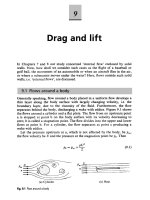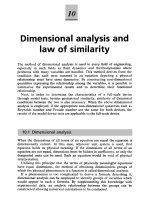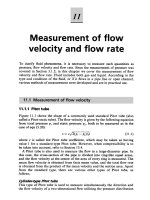Respiratory fluid mechanics lecture
Bạn đang xem bản rút gọn của tài liệu. Xem và tải ngay bản đầy đủ của tài liệu tại đây (4.52 MB, 57 trang )
Respiratory Fluid Mechanics
J.B. Grotberg, Ph.D., M.D.
Department of Biomedical Engineering
University of Michigan
Airw ay Branching Netw ork
Respiratory Zone
Airw ay and Alveolar Liquid Lining
Cultured human tracheobronchial airw ay epithelia
ML-mucus layer, PCL-periciliary layer, GCgoblet cell, CC-ciliated cell, BC-basal cell,
T-col-semipermeable supports
Alveolar liquid lining and
surfactant system
Airw ay Liquid Plugs: How Do They Occur?
• Intrinsic
– Normal people at full expiration
– Congestive Heart Failure → Pulmonary Edema
– Asthma, Emphysema
• Extrinsic
–
–
–
–
Surfactant Replacement Therapy
Delivery of Drugs, Genetic Material, Stem Cells
Liquid Ventilation
Drowning
Example of Extrinsic Plug:
Surfactant Replacement Therapy
mad
-- Surfactant replacement therapy
in premature infants.
-- Partial or total liquid ventilation.
-- Drug and gene delivery.
Biofluid Mechanics Lab
Experimental Setup – Lung Close-up
• The excised lung suspended and
ventilated from tracheal cannula.
• A small diameter tube attached
to a syringe w as inserted into the
cannula ( upper center of figure) .
• A surfactant bolus w as formed in
the cannula by injecting 0.05 ml of
surfactant through the small
diameter tube.
Cassidy, K.J., J.L. Bull, M.R. Glucksberg, C.A. Dawson,
S.T. Haworth, R.B. Hirschl, N. Gavriely and J.B.
Grotberg. J. Appl. Physiol. 2001.
(Courtesy of Robert Mothen, Medical College
of Wisconsin, Milwaukee, WI)
Anderson, J.C., R.C. Molthen, C.A. Dawson, S.T.
Haworth, J.L. Bull, M.R. Glucksberg and J.B. Grotberg.
J. Appl. Physiol. 2004.
Micro-CT Movie of Surfactant
I nstillation – Single Dose
Experimental Conditions
• Excised Rat Lung
• Lung Suspended Vertically
• Normal Bolus Volume
• Surfactant = Survanta
• Ventilation Rate - 60 br/ min
(Click image to start/stop movie)
Example of I ntrinsic Plug: Airw ay Closure
Liquid film
Air
Air
Cassidy et al., J. Appl. Physiol. 1999
Airway closure
Airway reopening
Instability & plug formation
plug propagation & rupture
Asymptotic Approach to Liquid Plug Propagation
Re=0, Ca1/3<<1, wall elastance & tension
Plug core viscous effects O(Ca), negligible
Transition regions dominate, G1→0 rigid
Generalized Landau-Levich Eq
Howell, Waters, Grotberg JFM 2000
h2 ( input) vs h1 ( output)
Outer, inner, intermediate regions
d (Vol plug )
dt
Plug Rupture Criteria:
Airw ay Reopening h1 > h2
2-D Steady Plug Propagation in Channel
Fujioka, Grotberg PoF 2005
Γ
C
y
H
U
x
P1
h1
•
•
•
•
•
σ(Γ)
Lp
n
∆P=P1-P2 drives plug at constant speed U.
h2=h1, for the steady state.
Soluble surfactant, Newtonian fluid.
Surfactant in far precursor film is prescribed.
Lp/H, h2/H=h1/H prescribed for steady state.
P2
h2
Flow Governing Equations
*
• Scaling with p = p /
µU
H
, u = u * / U , x = x* / H
• Dimensionless Navier-Stokes and the continuity equations.
Re ( u ⋅∇ ) u = −∇p + ∇ 2u
∇⋅u = 0
• Boundary condition along free interface.
− pn + ( ∇u + ∇uT ) ⋅ n = Ca −1 (σκ n + ∇ sσ ) − Pa n
n Normal vector on interface
u ⋅n = 0
κ
Curvature of interface
σ M Surface tension in surfactant-free interface
• Dimensionless Parameters
ρHU
µU
Re =
, Ca =
µ
σM
ρHU
Re ρσ M H
or Re =
,λ =
=
µ2
Ca
µ
Surfactant Transport Equations
• Scaling with
*
C = C * / Ccmc
, Γ = Γ* / Γ*∞
• Bulk surfactant transport equations.
Sc Re ∇ ⋅ ( uC ) = ∇ C
2
BC −
Scs
( n ⋅∇ ) C = jn
χ Sc
• Interfacial surfactant transport equations.
Scs Re ∇ s ⋅ ( uΓ ) − ∇ s 2 Γ = jn
• Dimensionless
Γ ∞*
µ
µ
Parameters, Sc = , Scs =
,χ=
ρD
ρ Ds
Ccmc* H
Γ*∞ Maximum monolayer packing value of Γ∗
*
Ccmc
Critical Micelle Concentration
Surfactant Transport Equations ( 2)
• Surfactant flux from the bulk to the interface
⎧⎪ K a Cs (1 − Γ ) − K d Γ
jn = ⎨
−Kd Γ
⎪⎩
( Γ < 1)
( Γ ≥ 1)
• Modified Frumkin equation of state
⎧
1 − EΓ
⎪
σ =⎨
⎡ E
⎤
E
1
exp
1
−
−
Γ
(
)
(
)
⎪
⎢⎣1 − E
⎥⎦
⎩
• Dimensionless Parameters,
ka Adsorption
( Γ < 1)
( Γ ≥ 1)
*
ka Ccmc
H2
kd H 2
Γ*∞ ∂σ *
, Kd =
, E=− *
Ka =
σ M ∂Γ*
Ds
Ds
rate coefficient
kd Desorption rate coefficient
Cs Bulk surfactant concentration in subsurface
Flow and Pressure: No Surfactant
1
|u|=1
y
0.5
0
SP
SP
Π1=0.56
Π:
-0.5
SP
0.5
-3
-2
0
-1
-1
-0.5
0
1
B
0.5
-2
x
1
2
Re=50, λ=1000, LP=0.5
•
•
•
•
•
0.5
Π = Ca ⋅ p = p* H / σ M*
SP
A
-1
-2 -1.5 -1 -0.5 0
4 stagnation points in the half-domain, all on the interface.
Two flow regions: recirculation and flow-through
Recirculation region low velocity
Capillary wave at front
Pressure minimized at A (in capillary wave)
3
4
Flow , Pressure, and Surfactant ( Lp= 0.5)
Re=50,λ=1000, LP=0.5, Sc=10, Scs=100,
Ka=104, Kb=102, χ=10-3, E=0.7, C0=10-4
1
10-3
SP
5x10 -3
2x
10 -3
0.5
SP
SP
C: 1.00E-04 1.00E-03 1.00E-02
|u|=1
SP
y
0
A
-0.5
Π1=0.82
0.5
-1
-3
•
•
•
•
0
-2
-1
-1
-0.5
0
x
Π:
-2 -1.5 -1 -0.5 0 0.5 1
B
Π = Ca ⋅ p = p* H / σ M*
0.5
1
2
3
4 stagnation points on midline, 2 on interface, 2 internal
The recirculation zone is no longer in contact with the interfaces.
Thicker transition region at front, thinnest point at B
The maximum concentration attains at the front meniscus
4
Flow , Pressure, and Surfactant ( Lp= 2.0)
Re=50,λ=1000, LP=2, Sc=10, Scs=100,
Ka=104, Kb=102, χ=10-3, E=0.7, C0=10-4
1
-3
10-3
C: 1.0E-04 1.0E-03 1.0E-02
2x10-3
0.5
|u|=1
SP
0
Π1=1.03
-0.5
y
5 x1 0
-0.5
0.5
-1
-3
-2
Π:
A
-2 -1.5 -1 -0.5 0
0.5
1
B
-1
0
0.5
-1
0
x
1
2
3
• Front meniscus stagnation pts. differ from rear.
• Velocity profiles fully developed at the middle cross-section ~ parabolic.
• Concentric iso-pressure lines appear due to centrifugal forces.
4
Wall Pressure and Shear Stress
λ=1000, LP=2, Sc=10, Scs=100, Ka=104,
Kb=102, χ=10-3, E=0.7, C0=10-4
0.50
1.25
0.40
1.00
0.30
0.50
0.20
0.25
0.10
0.00
τw
Πwall
0.75
-0.25
0.00
-0.10
-0.50
-0.20
Re=10
Re=30
Re=50
Re=70
-0.75
Re=10
Re=30
Re=50
Re=70
-1.00
-1.25
-1.50
-5
-0.30
-0.40
0
5
x
Wall Pressure
Π = Ca ⋅ p = p* H / σ M*
-0.50
-5
0
5
x
Wall Shear Stress
τ w = Ca
∂u
∂u * H
=µ * *
∂x
∂x σ M
• Wall pressure and shear increase with Re: can affect cells.
• In the front meniscus, both stresses oscillate in the capillary wave.
Unsteady Liquid Plug 2-D Channel: Initial Conditions
Fujioka, Grotberg
C
σ(Γ)
P1
h1
P 2=0
1-h 2
Lp
1-h 2
h2
• Hemi-sphere of the radius 1-h2, uniform film thickness of h=h2
• Initial velocity and bulk surfactant concentration are u=0 and C=C0
The initial interfacial surfactant concentration in equilibrium with C0.
• For no surfactant case, =1.
At t=0, a plug of the initial length, LP=1 starts propagating
with a constant pressure drop, P=P1-P2=1.
Effect of the precursor film thickness on Plug Propagation (no surfactant)
Effect of Surfactant on Plug Propagation
Plug Flow Dynamics Through Bifurcations
Zheng, Fujioka, Grotberg
Plug flows in airways:
deposits liquid along airway wall.
splits unevenly at bifurcation.
determines a final liquid distribution
t>0
t=0
B
A
U
Rs=LB / LA
Parent
V
Splitting ratio Rs = B
VA
LB
LA
(Y. Zheng, et al. JBE, 2005)
Pre-bifurcation asymmetry
α
g
B
Flow
A
Experimental setup
Video
Camera
g
Syringe
A
LB
B
HARVARD
Syringe Pump
A
γ
θ
φ
Computer
LA
Bifurcation Plates with Orientations
•
is branching angle of bifurcation, φ is roll angle and is pitch
angle.
L
Determine Rs (Ca,Bo, Vp, φ, γ)
Splitting ratio:
Rs =
B
LA
Simple Theoretical analysis on plug splitting
y
g
αd2
L2
P1
h
π1
a1
Up
π2
a2
θ
π0
x
a3
L1
P2 U2
π3
L3
P3 U3
αd3
• Compute pressure drops and mass balance between rear and front menisci
• Pressure drops
– Capillary jump + trailing thin film correction across rear mensicus (P1 – π1)
– Poiseuille law + gravity in liquid (π1 – π0, π0 – π2, π0 – π3 )
– Moving contact line effect at front menisci. P2 − π2(3) = ( σ / a 2 ) cos (α d )
cos αs − cos α d
• Empirical correlation for αd
= 2Ca1L 2
(Bracke et. al., Prog. Coll. Polymer Sci.,
1989
α)s + 1
cos
Results (low Re-low Ca expts.)
Effect of roll angle φ and pitch angle γ on Rs vs. Ca
0.9
1
0.8
0.9
0.8
0.7
0.7
0.6
0.6
Rs
0.5
Rs 0.5
0.4
0.4
0.3
0.3
0.2
0.2
0.1
0.1
0
0
0
0.02
0.04
0.06
Cap
0.08
0.1
0.12
LB-400-X oil, γ=0º. φ=15º:
(experiments),
(theory); φ =30º: (experiments),
(theory);
φ =60º: (experiments),
(theory).
•
•
•
•
0
0.02
0.04
0.06
0.08
0.1
0.12
Cap
LB-400-X oil, φ=30º. γ =-15º: (experiments),
(theory); γ=0º: (experiments),
(theory);
γ=15º:
(experiments),
(theory); γ=30º:
(experiments),
(theory).
A critical capillary number Cac exists below which Rs=0.
Cap increases, Rs increases.
Larger φ and γ cause smaller Rs but larger Cac.
Theory qualitatively agrees with experiments.









